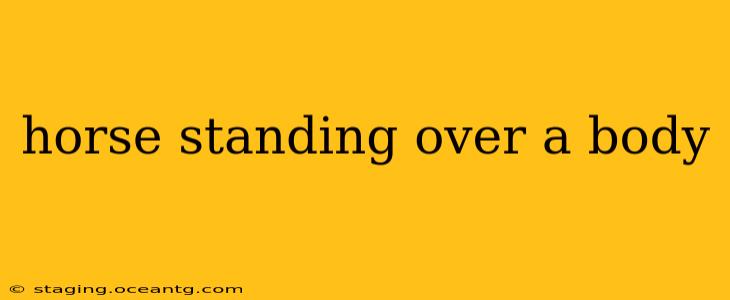The image of a horse standing over a body is inherently unsettling. It evokes a range of emotions and immediately raises questions about the circumstances surrounding the death. This situation requires careful investigation to determine the cause of death and the horse's role, if any, in the incident. This post will explore the various possibilities and considerations involved in such a scene.
What Could Cause This Scene?
Several scenarios could lead to a horse being found near a deceased individual. It's crucial to avoid jumping to conclusions. The horse's presence might be completely coincidental, or it might be directly or indirectly involved.
Accidental Death and Proximity:
The simplest explanation is that the death was unrelated to the horse. The individual might have suffered a heart attack, stroke, or other medical emergency in a field or area where the horse happened to be grazing. The horse's presence is purely coincidental. In this case, there would be no evidence of trauma related to the horse.
Accidental Injury Involving the Horse:
While less likely, the individual could have accidentally fallen and been injured, perhaps trampled or crushed by the horse in the confusion. This would require forensic evidence showing trauma consistent with being struck or stepped on by a horse. Witness accounts, if available, would be crucial.
Intentional Harm (Assault or Murder):
This is the most concerning possibility. The horse could have been used as a weapon in an assault or murder, or its presence might be a deliberate attempt to mislead investigators. This scenario would require a thorough investigation of the scene for evidence of struggle, defensive wounds on the victim, and any signs of the horse's involvement in the attack. Expert equine behaviorists might be consulted to determine if the horse displayed any unusual behavior before or after the incident.
Post-Mortem Interaction:
The horse might have simply wandered onto the scene after the death occurred. There's no indication of involvement, only proximity. This is a common scenario and easy to misinterpret as something sinister.
How Do Investigators Approach This Scene?
Investigating a scene involving a horse and a deceased individual requires a multi-faceted approach:
Securing the Scene:
The first step is to secure the scene and prevent any contamination or disturbance of potential evidence. This includes restricting access to the area and carefully documenting the location of the horse, the body, and all other objects.
Forensic Examination:
A thorough forensic examination of both the body and the surrounding area is essential. This includes a post-mortem examination to determine the cause of death, analyzing any potential injuries for evidence of trauma consistent with horse-related injuries (e.g., hoof prints, bite marks), searching for hair or other biological materials that could link the horse to the death.
Witness Interviews:
Gathering statements from any potential witnesses is crucial to reconstruct the events leading to the death. This includes anyone who may have seen the individual or the horse in the area before the incident.
Equine Expertise:
The involvement of equine experts, such as veterinarians or equine behaviorists, may be necessary to determine if the horse's behavior was unusual or if its presence might be connected to the death.
What if the Horse Shows Signs of Aggression?
A horse exhibiting aggressive behavior toward investigators could be a serious concern. It’s crucial to prioritize safety and only approach the situation with experienced personnel and appropriate equipment. The behavior itself may not indicate direct involvement in the death, but it warrants further investigation into the horse's temperament and history.
Conclusion: The Importance of Thorough Investigation
The discovery of a horse near a deceased individual necessitates a thorough and unbiased investigation. While a simple explanation might be the most likely outcome, the scene’s inherent ambiguity requires careful consideration of all possibilities before reaching any conclusions. The collaborative efforts of law enforcement, forensic experts, and potentially equine specialists are crucial for accurately determining the circumstances surrounding the death.
